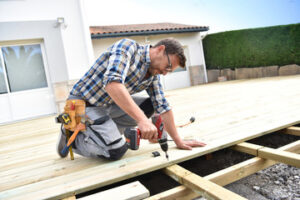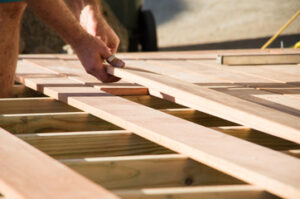Examine your deck regularly to nip problems in the bud. Look for protruding nails and any signs of insect infestation. Make sure the ledger board—which attaches your deck to the house—is secure. Check joists and support posts for rot.

Examine each deck board for signs of infestation or rot, as well as for small holes or a soft feeling. Ensure that the boards have proper gapping for drainage and airflow. Visit Website to learn more.
A deck needs to be inspected regularly to ensure that it can safely support the weight of people and furniture. During an inspection, a professional will look for signs of damage or deterioration that might not be apparent to the untrained eye, including hidden rot, pest infestation and structural damage.
The wood of a deck can be damaged by water and the elements, leading to problems such as warping, rot, sagging and mold. Stairs can be particularly dangerous if they are not properly installed and maintained, but an inspector will check to make sure that the stairs are safe. Inspecting stairs includes looking at the treads and stringers, making sure that they are free of rot or other damage and checking to see that the handrails are sturdy.
An important thing to keep in mind about inspecting a deck is that cleaning and refinishing won’t fix any issues that have arisen as a result of the original construction or landscaping. This is why it’s so important to have a professional inspection done before deciding on a particular maintenance plan.
As part of a routine inspection, the inspector will walk around the deck and give it a shake to check for loose boards. He or she will also examine the fasteners and any other metal components to make sure that they are not rusting or otherwise compromised. The inspector will also pay special attention to the ledger, the piece of framing that attaches the deck to the house. This is one of the main causes of deck collapse, and it’s critical that this connection be made correctly.
A professional inspection will also check the joists, as well as any support posts that may be located under the deck. He or she will look for rot and decay in the wood, and will test the integrity of the structure by trying to pry a piece of wood loose with a screwdriver. If the wood breaks apart without splintering, it is likely healthy, but if it is soft and spongy or dark in color, it is probably rotting.
Cleaning
The cleaning process can affect your deck’s lifespan and look, so it is important to perform it properly. Using too much pressure or scrubbing can damage the wood fibers and cause it to splinter. Use a garden hose or low pressure sprayer with a biodegradable wood deck cleaner. Spray the solution over the surface of your deck, and scrub it with a brush to remove dirt, mildew, mold, and stains. Then, rinse the deck with a water hose and allow it to dry.
Properly cleaning and maintaining your deck will help to prevent the growth of algae, mold and mildew, which can lead to rot. It will also make your deck safer for family and guests to use.
Before cleaning your deck, you should clear it of any furniture and prepare the surrounding area. This includes covering nearby plants, bushes and other landscaping with plastic sheeting or tarps to protect them from overspray or runoff during the cleaning process. It is also a good idea to trim any overhanging branches or limbs that could fall on the deck.
It is important to clean your deck at least twice per year. A good time to do this is in the spring and again in the fall.
After your deck has been cleaned, you should let it dry for a few days before staining or sealing. You should also be sure to follow the instructions on the cleaning product that you choose.
Lastly, if your deck is made of composite material, you can use vinegar to remove spores and seeds that cause Algae, Mold and Mildew to grow. Follow the manufacturer’s instructions for dilution. Then, apply a deck brightener (like Penofin) to neutralize the oxidation in the wood and keep it looking its best.
In addition to regularly cleaning and sweeping your deck, you should also replace any nails or screws that are loose or protruding from the boards. These can cause a tripping hazard, and they will also attract insects to the deck. You should also avoid outdoor rugs that are made of natural materials, such as jute and bamboo, as they absorb moisture and promote the growth of mildew.
Sealing
The right deck sealant can protect your deck from water damage, UV rays and the growth of mildew. It also adds a nice color boost.
When sealing, be sure to choose a product designed for your type of wood and follow the manufacturer’s instructions. You’ll likely need to apply a minimum of two coats, with the interval between each dependent on weather conditions and your climate zone.
Before you start applying sealant, thoroughly clean your deck to remove any dirt or debris that has collected. Then, allow the deck to dry for the number of days recommended by the manufacturer. During this time, keep an eye out for any boards that have worked loose during the cleaning process.
If necessary, re-stain the areas that have been stripped down to the bare wood. This is a great opportunity to replace any broken or missing boards and to re-screw any loose ones.
The best deck sealers offer a natural finish that allows the wood grain to show through, while protecting it from moisture and UV damage. If you use a clear sealant, it will need to be reapplied more frequently, typically every 1-2 years. Semi-transparent sealers provide a subtle tint and offer more UV protection, but they too will need to be reapplied periodically. Solid stain sealants offer the highest level of UV protection, but they are not a permanent solution and will need to be reapplied every 3-5 years.
Remember that any planters, tables or chairs that are on the deck must be moved to a different location while the deck is being sealed. Otherwise, the sealant will drip onto the plants and can prevent them from absorbing the moisture they need to thrive.
Whether you use a brush, roller or paint sprayer to apply the sealant, it is important to work slowly and methodically. Trying to rush the job will result in an uneven surface that is prone to chipping and peeling. In addition, be sure to select a day that is neither too hot nor too cold, as the temperature and time of day affect how well your sealant will absorb and cure.
Refinishing
The elements take a toll on your deck, gradually wearing it down and affecting its resilience. The most effective way to extend its life is through consistent maintenance that includes cleaning, inspection, and the application of protective finishes. Regular inspections will help you spot problems that might otherwise go unnoticed. These include loose boards, cracks and other superficial damage that can eventually lead to structural instability. It is also important to address any signs of rot or insect infestation, as these issues can be quite serious if left unattended.
Routinely sweeping and washing the deck with appropriate wood cleaners can also reduce the need for more drastic interventions like sanding. These products remove accumulated dirt and debris, and they are available in a variety of colors to match your home. A wood brightener can help restore the natural beauty of your deck, and some contain mildewcide to combat discoloration caused by mold and mildew. Finally, a deck stain can be used to protect the surface and reduce the occurrence of water-related problems.
When you are ready to refinish your deck, be sure to consult the weather forecast and plan for any rainy or cold conditions that could ruin your work. It is also important to protect nearby plants and shrubs from any cleaners or chemicals you might use. Staining and sealing are best done in the spring or fall, when the temperatures are moderate and not too hot or too cold.
Sanding your deck is a necessary step to prepare it for new stain or paint, and it can be a bit tricky to get it right. Over-sanding can leave the deck looking dull and weakened, while under-sanding leads to uneven surfaces that can be damaged by water or sun.
Begin with a coarse grit to remove major imperfections and old finishes, then slowly move to finer grits until the deck is smooth and ready for staining. Once the deck is sanded, you can apply a stain with a color that matches your home and provides the level of protection you desire.
